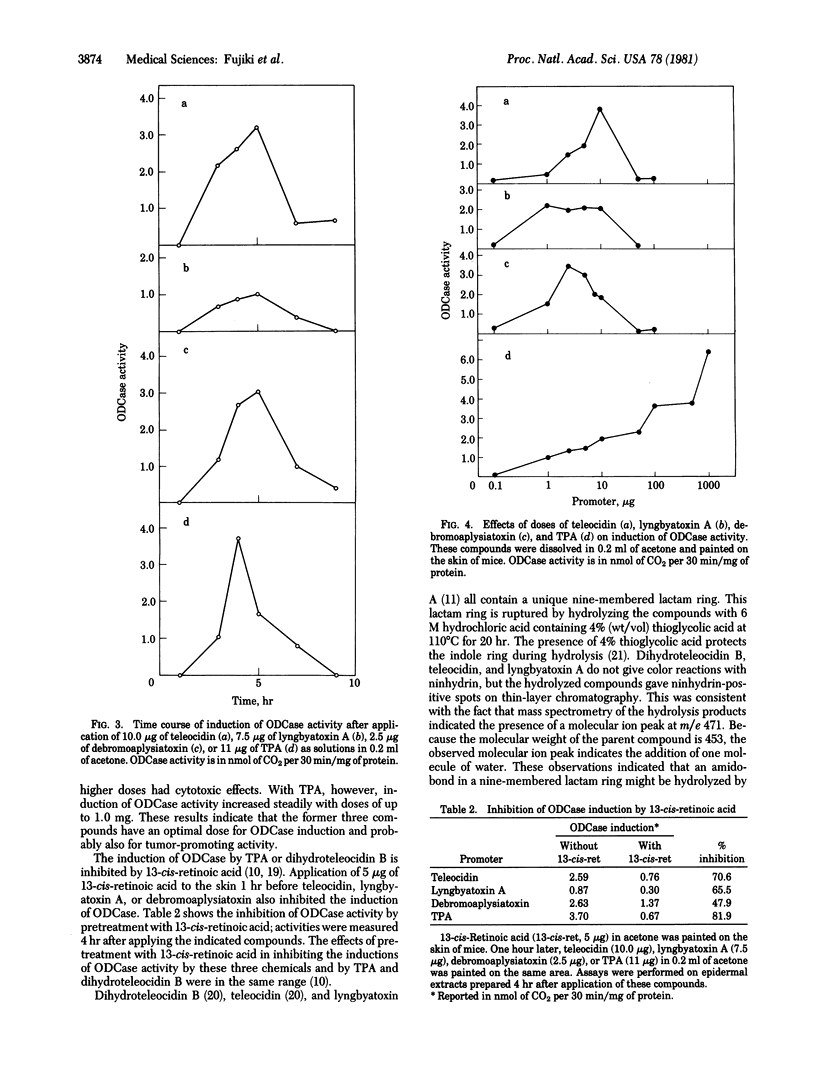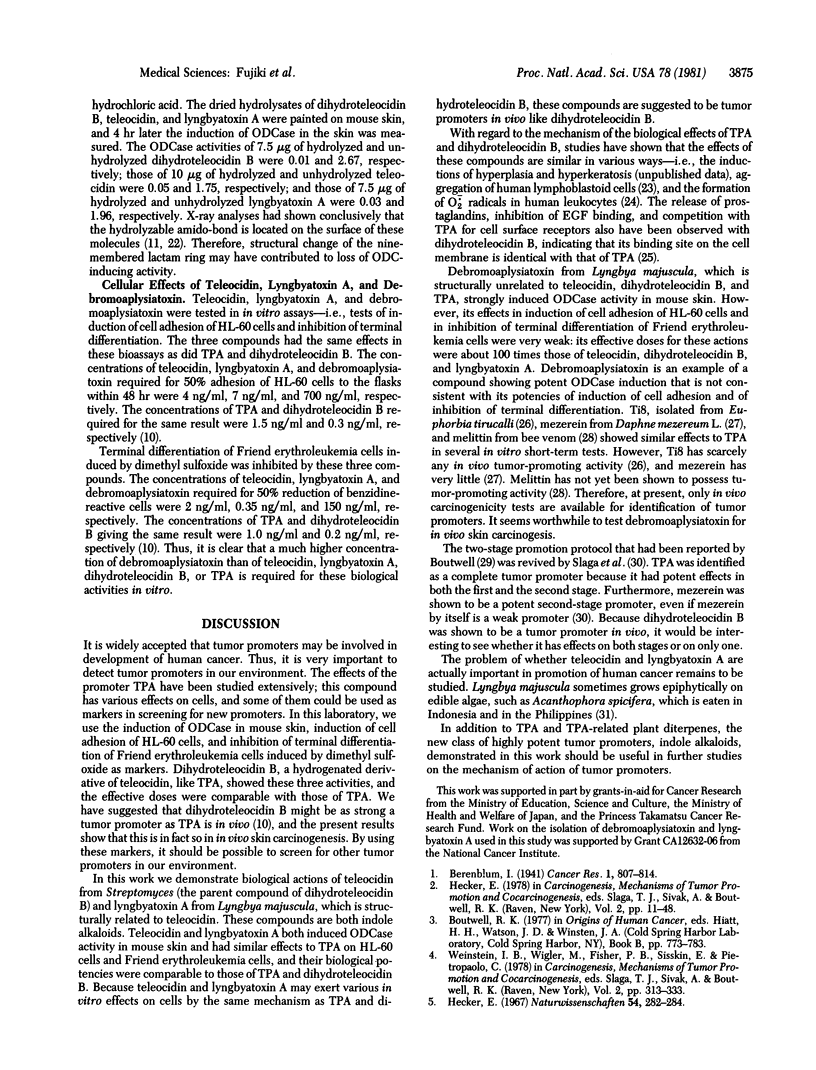Abstract
Dihydroteleocidin B, which is a derivative of teleocidin from Streptomyces, showed potent tumor-promoting activity in vivo when painted on mouse skin. Although the chemical structure of dihydroteleocidin B is entirely different from those of phorbol esters, the tumor-promoting activity of dihydroteleocidin B was found to be comparable to that of 12-O-tetradecanoylphorbol 13-acetate (TPA) in vivo. Teleocidin from Streptomyces and lyngbyatoxin A and debromoaplysiatoxin from the marine blue-green alga Lyngbya majuscula induced ornithine decarboxylase activity when painted on mouse skin, their effects being similar to those of dihyroteleocidin B and TPA. 13-cis-Retinoic acid inhibited this ornithine decarboxylase induction when painted on the skin 1 hr before these natural products. These three compounds produced adhesion of human promyelocytic leukemia cells (HL-60) to the flasks and inhibited differentiation of Friend erythroleukemia cells induced by dimethyl sulfoxide. The in vitro biological potencies of teleocidin and lyngbyatoxin A were almost as great as those of dihydroteleocidin B and TPA, but that of debromoaplysiatoxin was much weaker.
Full text
PDF




Selected References
These references are in PubMed. This may not be the complete list of references from this article.
- BOUTWELL R. K. SOME BIOLOGICAL ASPECTS OF SKIN CARCINOGENISIS. Prog Exp Tumor Res. 1964;4:207–250. doi: 10.1159/000385978. [DOI] [PubMed] [Google Scholar]
- Cardellina J. H., 2nd, Marner F. J., Moore R. E. Seaweed dermatitis: structure of lyngbyatoxin A. Science. 1979 Apr 13;204(4389):193–195. doi: 10.1126/science.107586. [DOI] [PubMed] [Google Scholar]
- Doll R. Strategy for detection of cancer hazards to man. Nature. 1977 Feb 17;265(5595):589–596. doi: 10.1038/265589a0. [DOI] [PubMed] [Google Scholar]
- Fujiki H., Mori M., Nakayasu M., Terada M., Sugimura T. A possible naturally occurring tumor promoter, teleocidin B from Streptomyces. Biochem Biophys Res Commun. 1979 Oct 12;90(3):976–983. doi: 10.1016/0006-291x(79)91923-5. [DOI] [PubMed] [Google Scholar]
- Goldstein B. D., Witz G., Amoruso M., Stone D. S., Troll W. Stimulation of human polymorphonuclear leukocyte superoxide anion radical production by tumor promoters. Cancer Lett. 1981 Jan;11(3):257–262. doi: 10.1016/0304-3835(81)90117-8. [DOI] [PubMed] [Google Scholar]
- Hecker E. Phorbol esters from croton oil. Chemical nature and biological activities. Naturwissenschaften. 1967 Jun;54(11):282–284. doi: 10.1007/BF00620887. [DOI] [PubMed] [Google Scholar]
- Hoshino H., Miwa M., Fujiki H., Sugimura T. Aggregation of human lymphoblastoid cells by tumor-promoting phorbol esters and dihydroteleocidin B. Biochem Biophys Res Commun. 1980 Jul 31;95(2):842–848. doi: 10.1016/0006-291x(80)90864-5. [DOI] [PubMed] [Google Scholar]
- Marks F., Bertsch S., Fürstenberger G. Ornithine decarboxylase activity, cell proliferation, and tumor promotion in mouse epidermis in vivo. Cancer Res. 1979 Oct;39(10):4183–4188. [PubMed] [Google Scholar]
- Matsubara H., Sasaki R. M. High recovery of tryptophan from acid hydrolysates of proteins. Biochem Biophys Res Commun. 1969 Apr 29;35(2):175–181. doi: 10.1016/0006-291x(69)90263-0. [DOI] [PubMed] [Google Scholar]
- Mufson R. A., Fischer S. M., Verma A. K., Gleason G. L., Slaga T. J., Boutwell R. K. Effects of 12-O-tetradecanoylphorbol-13-acetate and mezerein on epidermal ornithine decarboxylase activity, isoproterenol-stimulated levels of cyclic adenosine 3':5'-monophosphate, and induction of mouse skin tumors in vivo. Cancer Res. 1979 Dec;39(12):4791–4795. [PubMed] [Google Scholar]
- Mufson R. A., Laskin J. D., Fisher P. B., Weinstein I. B. Melittin shares certain cellular effects with phorbol ester tumour promoters. Nature. 1979 Jul 5;280(5717):72–74. doi: 10.1038/280072a0. [DOI] [PubMed] [Google Scholar]
- Mynderse J. S., Moore R. E., Kashiwagi M., Norton T. R. Antileukemia activity in the Osillatoriaceae: isolation of Debromoaplysiatoxin from Lyngbya. Science. 1977 Apr 29;196(4289):538–540. doi: 10.1126/science.403608. [DOI] [PubMed] [Google Scholar]
- O'Brien T. G., Simsiman R. C., Boutwell R. K. Induction of the polyamine-biosynthetic enzymes in mouse epidermis by tumor-promoting agents. Cancer Res. 1975 Jul;35(7):1662–1670. [PubMed] [Google Scholar]
- Slaga T. J., Fischer S. M., Nelson K., Gleason G. L. Studies on the mechanism of skin tumor promotion: evidence for several stages in promotion. Proc Natl Acad Sci U S A. 1980 Jun;77(6):3659–3663. doi: 10.1073/pnas.77.6.3659. [DOI] [PMC free article] [PubMed] [Google Scholar]
- Terada M., Fried J., Nudel U., Rifkind R. A., Marks P. A. Transient inhibition of initiation of S-phase associated with dimethyl sulfoxide induction of murine erythroleukemia cells to erythroid differentiation. Proc Natl Acad Sci U S A. 1977 Jan;74(1):248–252. doi: 10.1073/pnas.74.1.248. [DOI] [PMC free article] [PubMed] [Google Scholar]
- Umezawa K., Weinstein I. B., Horowitz A., Fujiki H., Matsushima T., Sugimura T. Similarity of teleocidin B and phorbol ester tumour promoters in effects on membrane receptors. Nature. 1981 Apr 2;290(5805):411–413. doi: 10.1038/290411a0. [DOI] [PubMed] [Google Scholar]
- Van Duuren B. L. Tumor-promoting agents in two-stage carcinogenesis. Prog Exp Tumor Res. 1969;11:31–68. doi: 10.1159/000391388. [DOI] [PubMed] [Google Scholar]
- Verma A. K., Boutwell R. K. Vitamin A acid (retinoic acid), a potent inhibitor of 12-O-tetradecanoyl-phorbol-13-acetate-induced ornithine decarboxylase activity in mouse epidermis. Cancer Res. 1977 Jul;37(7 Pt 1):2196–2201. [PubMed] [Google Scholar]
- Weber J., Hecker E. Cocarcinogens of the diterpene ester type from Croton flavens L. and esophageal cancer in Curaçao. Experientia. 1978 Jun 15;34(6):679–682. doi: 10.1007/BF01947253. [DOI] [PubMed] [Google Scholar]
- Yamasaki H., Fibach E., Nudel U., Weinstein I. B., Rifkind R. A., Marks P. A. Tumor promoters inhibit spontaneous and induced differentiation of murine erythroleukemia cells in culture. Proc Natl Acad Sci U S A. 1977 Aug;74(8):3451–3455. doi: 10.1073/pnas.74.8.3451. [DOI] [PMC free article] [PubMed] [Google Scholar]


